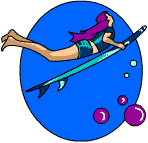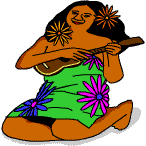Surfing San Diego, California, USA
Created | Updated Feb 14, 2002
A Short Digression

Surf is created by waves striking something below the surface. When a wave's energy hits something large and immovable, like a continent or reef, the wave begins to 'break' or crash upon the thing that's blocking its path. With the right combination of wave energy and surface shape of the object being struck, a surfable wave is formed. The more these factors harmonize, the better the surf's shape.
General Information on Surfing San Diego, California
San Diego, located in Southern California, is a great place to surf. It's about as as South and West (simultaneously) as you can be while within the continental USA. San Diego generally has good surf all year (but it is rarely great). The beaches and reefs around San Diego enjoy larger surf in the winter, with 'swells' travelling down from Alaska and the Arctic Circle. In the summer, San Diego sees larger swells that push in from storms that form around New Zealand and the Southern Hemisphere. With a lot of luck, there are the occasional hurricanes (this is very rare) that form around Southern Mexico and Central America and move westerly out to sea. When these conditions exist, the storms can generate large surf for San Diego. While it does sometimes happen, it is unusual for San Diego's surf to be as large and consistent as you find in Hawaii.
A good place to see the surf forecast for Southern California is from Wetsand.com. They are really good at knowing what type of surf is going to hit in the next few days. Another good link to check out is the Pacific BeachCam; this is a live Java camera from Pacific Beach, California that pans up and down the beach to a number of breaks (PB Point/Tourmaline, Law Street, and The Pier). These also have links to other surf camera locations and are worth a look. A few things to remember when you go out into the surf:
Don't drop in on people. That is, don't try and catch a wave that someone else is already riding, unless they invite you on their wave or it's your best friend. This is the first and most important rule you should remember when you venture into the surf.
The surf is usually larger during the autumn and winter months. This is because the swells originate closer to California, usually breaking off the Russian coast or from along Alaska's Aleutian chain of islands.
It is always a good idea to shuffle your feet when you are walking in the surf. This prevents you from being stung by one of the sting rays that like to summer in the shallows of San Diego's beaches.
Keep an eye on the locals. Keep your eye out for the surfers who look like they know what's going on, and ask them for some tips and information. If you can make friends with them, they can help you find your way around the lineup1 and around town; maybe even invite you to a party where you can meet more surfers.
Breaks (Places to Surf)
Starting at the southern-most point along California's coast and moving north:
Baja, California, Mexico has great surfing along the Western coast and extends hundreds of miles to the South of San Diego, California, USA.
Imperial Beach is located at the Southern end of San Diego County. There are a number of breaks to visit.
Silver Strand/Coronado Island are wide open beaches with some spots that get the occasional swell. Be careful, the US Navy SEALS train along the Silver Strand and much of the area is off limits.
Sunset Cliffs (OB) has reef breaks galore. Usually better at low tides, but is difficult to access.
Ocean Beach Pier has steep rights and lefts, better with a mixed swell. Localism can be a problem.
Dog Beach can be good, but the water is usually dirty from run-off.
South Mission Jetty is a good left. The harbour jetty catches West and North Swells and they jack up. Good for short boards and a fast longboard. Watch for thugs.
Mission Beach has a lot of beach sites to paddle out and have fun. Can be good, but is usually not.
Pacific Beach Drive or 'PB Drive' is a great beach break. Good rights and lefts. Works well at most tides.
Chrystal Pier is a popular location for shortboarding, but for some reason they always have longboard contests here.
Diamond/Law Streets are named after the streets in Pacific Beach where they are located in front. Beach breaks that have their moments. Gets crowded after 5pm during the summer. Diamond St is subject to no surfing (Black Balled) and is restricted to swimming only.
The Pump House is a building on the beach just below the cliffs used to pump treated sewage 6 miles offshore. In front of the Pump House is an (occasionally) awesome left.
Tourmaline Surfing Park is a slow, often mushy, reef break. There are times when it is really fun, but the conditions need to be good for this to happen (unusual). It is likely because of the parking and easy access to the beach that causes this place to be loaded with too many surfers, often individuals who are just learning. This location does well at most tides, except very high tides.
PB Point is a classic right point break. Better at medium and high tides. Needs a solid N, NW, WNW swell to really work. Localism can be a big problem. Don't go alone, but don't bring too many either.
Hermos/Haniman's are reef breaks north of PB Point. Avoid the low tides.
South Bird is another reef break, just south of Bird Rock.
Bird Rock is a reef break that sits in front of Bird Rock in La Jolla (a community of San Diego). Needs a larger swell and a medium to high tide. Access can be difficult when the surf is really large.
North Bird consists of Devil's, Bells and Sybil's. Fickle.
Reed's/Hogan's/Vietors are difficult to see or get to and they need bigger surf.
Big Rock is a world class left. On smaller days it can be a fun drop and shoulder to crank a turn. On bigger days it can kill. The take-off is just over (or next to) Big Rock and barrels for three to 15 feet (1 - 5m) and then softens up for a few tricks or cutbacks. If it's good, it's crowded. Watch for localism/bullies.
WindanSea is world famous. Surfing in San Diego pretty much started here back in the day. Fast lefts and rights. Can be steep and the left is tricky if you don't know what to expect. Usually crowded from 6.15am to 7.45pm, every day. Watch out for locals who aren't friendly. Usually the unfriendly 'locals' are individuals who don't actually live near WindanSea because it's too expensive to live in La Jolla2 but for some reason still think WindanSea is their personal break.
Simmons/Brock's Rock sometimes breaks, mostly doesn't.
Rockpile/Marine St - these can be good, worth a look.
Hospitals - a good short board spot.
La Jolla Left/Coast Blvd. Park have waves. Watch for parking tickets in La Jolla.
The Casa/Children's Pool is a semi-enclosed swimming area from the 1920s that has been allowed to return to the native seal population. There is no use allowed of this area except for watching seals, which can be fun and is worth a quick look if you are in the area.
Seal Rock is a nice spot to look at because there are usually seals sitting on the rock, sunning them selves. On large days there can be some good tubes here - usually these are too fast to ride.
Point La Jolla (aka The Cove) is only good when the swells are over 12 feet (4m); the bigger, the better. Watch for the rocks and caves on the inside.
The Marine Room is a fancy restaurant that sits alongside the beach that has a nice reef/beach break in front. Access is next to the restaurant's parking lot.
La Jolla Beach Club/Sea Lodge are okay beach breaks, but are swimming only in the summer.
La Jolla Shores is a fun beach break, with fast rights and lefts. Lots of people in and out of the water. Popular with people because of easy parking/beach access.
Archie's Left/Green Walls are better at bigger swells, but are okay to learn on when the surf is small.
Lots/South Side is just south of the Scripp's Pier. Steep rights and lefts. Mostly shortboard material. Watch out for mean locals and dangerous (unskilled) tourists.
Scripps North Side is just north of the Scripp's Pier. Fun, slower waves. Good place to spend a day away from the crowd that starts forming south of the pier.
Dike Rock is another beach break, a long walk up the beach from Scripps.
Black's Beach is world famous and is a powerful, often overhead surf spot. Located below the cliffs of Torry Pines State Preserve, and the glider port. This break picks up many swells because of its proximity to an ocean canyon that terminates here, thereby channeling a lot of energy to this spot. Access is difficult if you don't have a key to the private lot, which isn't likely because only a few people have a key. You can make the walk down the cliff in 10 to 15 minutes along one of the marked trails. Be careful to follow a marked trail or you may end up falling over 100 feet (30m).
Torry Pines State Beach is nothing special, but is easy to access from US 101.

There are many more surf locations in North San Diego County, including Del Mar (various spots along the coast), Stone Steps is worth checking (at the end of Villa de la Valle). Further north is Table Tops/Sea Side, there are often surfing contests held at Sea Side. Cardiff Reef is a well known break with fun rights and lefts, and breaks on almost any swell. San Elijo State Beach has a bunch of reef breaks and just up the 101 is another famous spot, Swami's. Further North you can surf Terra Mar, Ponto Jetty, Tamarack, Oceanside Pier, Oceanside Harbor Jetty, all the way up to San Onofre State Beach, a classic surf spot since the 1930s.
Additional Information
Remember, there are many surf shops in San Diego loaded with information. Quite how such a large number of surf shops can survive, and in some cases thrive, when they share the same block (often located next to or across the street from one another) is quite baffling when one considers that most surfers never appear to have any money. Stop by one along Mission Avenue in Pacific Beach and someone can point you toward the surf area that is right for you. The surf changes every day, hour to hour. A spot that may have been perfect early in the morning can turn into something less than fun after a little wind or a tidal change. If you have never surfed and don't know what you are doing, take a lesson. This can save you from hurting yourself and others.
Good Luck and Mahalo!
Some Surfing Related Sites Worth Checking Out:
- Cardiff Reef Camera
- San Diego Surfing Academy
- San Diego Lifeguards
- The Surfrider Foundation
- Rusty Farrell's Surf School

